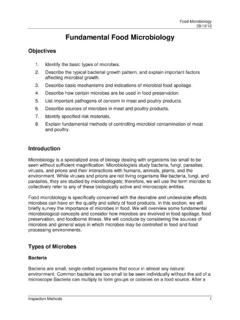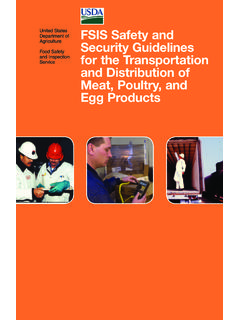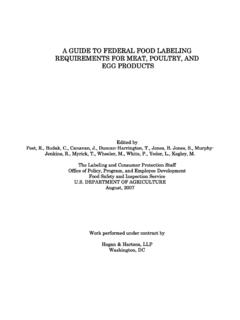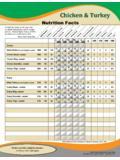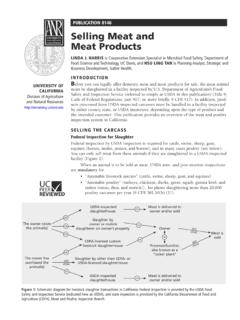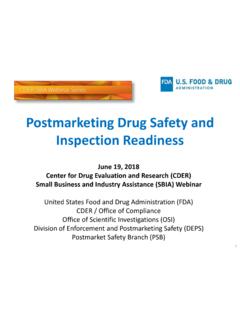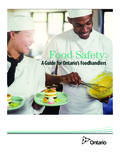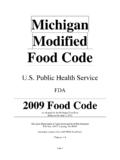Transcription of Microwave Ovens and Food Safety
1 United States Department of Agriculture food Safety and inspection Service food Safety Information Microwave Ovens and food Safety T he Microwave oven is one of the great inventions of the 20th century; over 90% of homes in America have at least one. Microwave Ovens can play an important role at mealtime, but special care must be taken when cooking or reheating meat, poultry, fish, and eggs to make sure they are prepared safely. Microwave Ovens can cook unevenly and leave cold spots where harmful bacteria can survive. For this reason, it is important to use a food thermometer and test food in several places to be sure it has reached the recommended safe temperature to destroy bacteria and other pathogens that could cause foodborne illness.
2 How do microwaves The magnetron inside the oven converts ordinary electric power from a wall cook food ? socket into very short radio waves (around 4 inches from crest to crest). They are transmitted by the oven's magnetron at a frequency of about 2450 Megahertz. At that frequency, power is readily absorbed by water, fats and sugars, resulting in very fast vibration and high temperatures that cook the food . What are power levels? On high power, the food is subjected to the highest amount of Microwave energy because the magnetron produces microwaves at full capacity.
3 To produce a power level less than high (100%), the magnetron cycles off and on. For example, medium power (50%) means that the oven produces microwaves 50% of the time and is off 50% of the time. Foods best to cook on high power are basically tender foods and those with a high moisture content such as ground beef, poultry, vegetables and fruits. Eggs, cheese and solid meat can toughen when microwaved on high. They are best cooked on reduced power. Large cuts of meat should be cooked on medium power (50%) for longer periods. This allows heat to reach the center without overcooking outer areas.
4 Do microwaves cook No. Microwaves penetrate the food to a depth of 1 to 1 1/2 inches. In thicker food from the inside pieces of food , the microwaves don't reach the center. That area would cook by conduction of heat from the outer areas of the food into the middle. In a Microwave oven, the air in the oven is at room temperature so the temperature of the food surface is cooler than food in a conventional oven where the food is heated by hot air. Therefore, food cooked in a Microwave oven doesn't normally become brown and crispy. Do microwaves cook Bacteria will be destroyed during Microwave cooking just as in other types of food safely?
5 Ovens , so food is safe cooked in a Microwave oven. However the food can cook less evenly than in a conventional oven. Microwave cooking can be uneven just as with frying and grilling. For that reason, it is important to use a food thermometer and test food in several places to be sure it has reached the recommended temperature to destroy bacteria and other pathogens that could cause foodborne illness. To promote uniform cooking, arrange food items evenly in a covered dish and add some liquid if needed. Where possible, debone large pieces of meat; bone can shield meat from thorough cooking.
6 The food Safety and inspection Service (FSIS) is the public health agency USDA Meat & Poultry Hotline in the Department of Agriculture responsible for ensuring that the na- tion's commercial supply of meat, poultry, and egg products is safe, whole- 1-888-MPHotline some, and correctly labeled and packaged. (1-888-674-6854). Microwave Ovens and food Safety Cover the dish with a lid or plastic wrap. Allow enough space between the food and the top of the dish so that plastic wrap does not touch the food . Loosen or vent the lid or wrap to allow steam to vent.
7 The moist heat that is created will help destroy harmful bacteria and ensure uniform cooking. Cooking bags also provide safe, even cooking. Stir, rotate, or turn food upside down (where possible) midway through the microwaving time to even the cooking and eliminate cold spots where harmful bacteria can survive. Even if the Microwave oven has a turntable, it's still helpful to stir and turn food top to bottom. Follow cooking instructions on product label (or recipe instructions). If a range of time is given, start with the fewest minutes recommended.
8 Add cooking time if necessary to reach a safe internal temperature. Observe the standing time. Cooking continues and is completed during standing time. Most importantly, follow the manufacturer's instructions. What is standing time ? Microwaves cause water, fat, and sugar molecules to vibrate million times per second, producing heat. After the oven is off or food is removed from the oven, the molecules continue to generate heat as they come to a standstill. This additional cooking after microwaving stops is called carryover cooking time, resting time, or standing time.
9 It occurs for a longer time in dense foods such as a whole turkey or beef roast than in less-dense foods like breads, small vegetables and fruits. During this time, the temperature of a food can increase several degrees. For that reason, directions may advise to let a food rest for a few minutes after turning off the oven or removing food from the oven. Use a food thermometer or the oven's temperature probe to verify the food has reached a safe internal temperature. Unless the food thermometer is labeled safe for Microwave cooking, do not leave the thermometer in the food during microwaving.
10 Instead, use an instant read food thermometer to test the temperature of the food after removing it from the Microwave oven. What are the USDA Place the thermometer in the thickest area of the meat or poultry not recommended near fat or bone and check the temperature in the innermost part of the thigh and wing and in the thickest part of the breast of whole poultry. temperatures for Cooking times may vary because Ovens vary in power and efficiency. microwaving food Cook ground meats to 160 F as measured with a food thermometer. safely?
